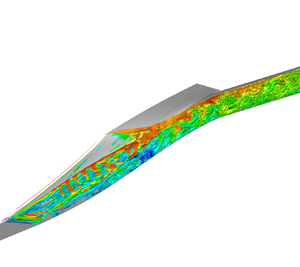Article contents
Low-frequency unsteadiness mechanisms of unstart flow in an inlet with rectangular-to-elliptical shape transition under off-design condition at a Mach number of 4
Published online by Cambridge University Press: 22 August 2024
Abstract

The unsteady mechanism of unstart flow for an inlet with rectangular-to-elliptical shape transition (REST) under the off-design condition at a Mach of 4 is investigated using the delay detached eddy simulation method. With the help of numerical simulations, the unsteady dynamics, especially the low-frequency characteristics of the REST inlet unstart flow, as well as the self-sustaining mechanism, is investigated. The instantaneous flow illustrates the unsteady phenomena of the REST unstart flow, including the interaction between the cowl-closure leading edge (CLE) shock and the shear layer, breathing of the separation bubble, flapping of the separation shock, instability of the shear layer and vortex shedding along the shear layer. The spectral analysis reveals that the lower frequency dynamics is associated with the breathing of the separation bubble and the flapping motion of the separation shock wave, while the higher frequency is related to the instability of the shear layer affected by cowl-closure leading edge shock and the formation of shedding vortices. Further, coherence analysis shows that the contribution of these flow structures dominating the low-frequency dynamics couple with each other. Based on the dynamic mode decomposition results, the characteristics that contribute to the unsteady behaviour of unstart flow are summarized. The streamwise vortices downstream of the separation and the shedding vortices are believed to be the main driving force of the global low-frequency unsteadiness of the REST inlet unstart flow under the off-design condition. Moreover, the CLE shock plays an important role in the process during the dominant flow structure conversion from the backflow within the separation bubble into elongated streamwise structures.
Information
- Type
- JFM Papers
- Information
- Copyright
- © The Author(s), 2024. Published by Cambridge University Press
References
- 3
- Cited by


